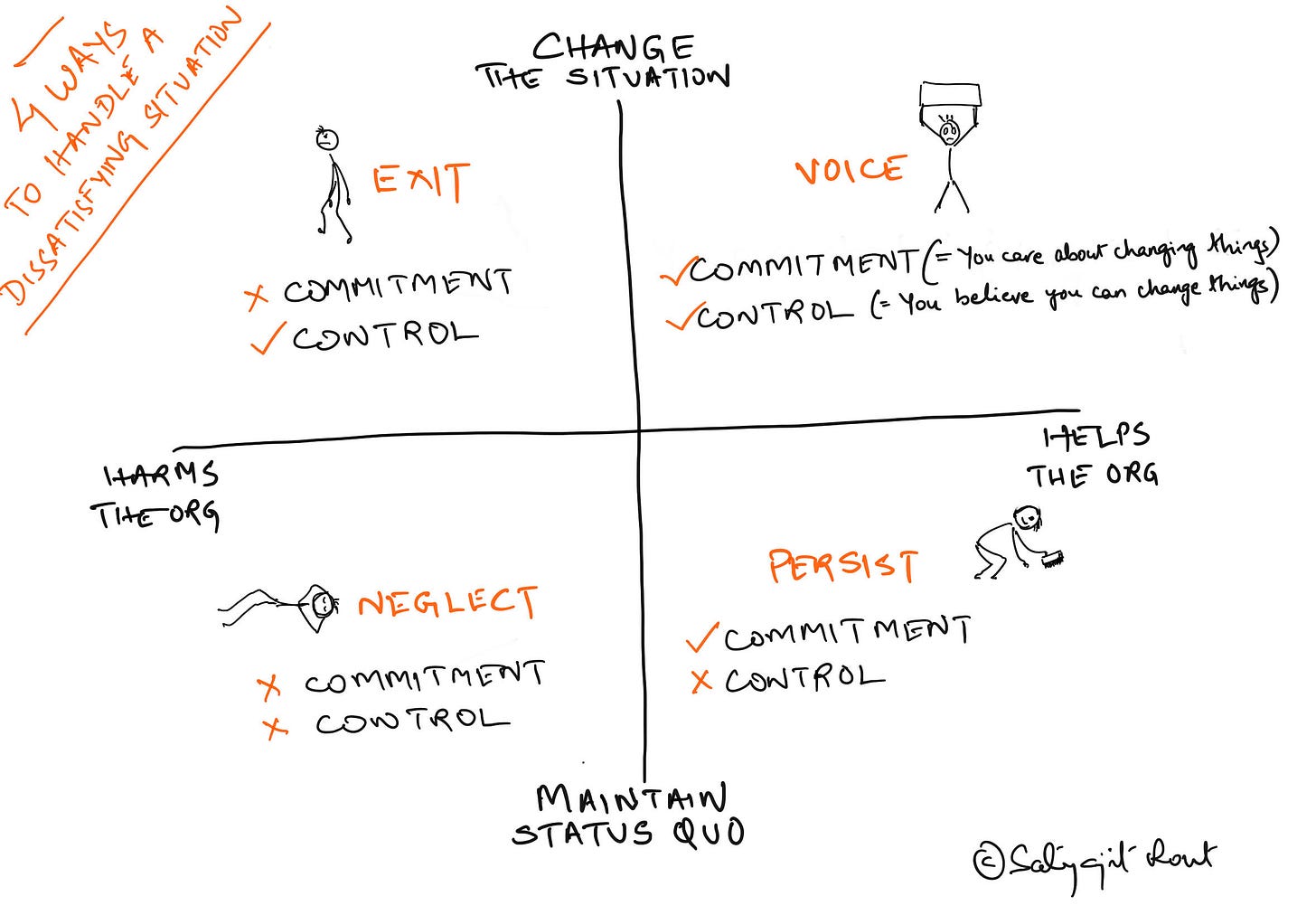#182 - The four ways people show dissatisfaction
Decoding the behavior of those you lead and work with
If you’re a leader in charge of a team or business unit that is made up of other people managers and individual contributors, here is a framework to understand how they may be handling their unhappiness at work so that you can choose to respond to them better.
This framework is an adaptation of ideas expressed in a 1970 book called Exit, Voice, and Loyalty by economist Albert Hirschman. I must confess that in 2021 when I had first read about the framework, I had completely ignored the source material and only looked at their reworking by Adam Grant in his book Originals. (I’m correcting that anomaly now.)
📢When you’re unhappy with your job, you tend to see your choices as one of these four: exit, voice, persist, or neglect.
The underlying framework works as well for understanding migration, personal relationships, and protest movements. In this piece, we’ll stick to jobs.
Let’s understand these four choices for Sheila, someone in your team who is displeased with the state of affairs, with a simple visual.
Exit - Removing herself from the unhappy situation, which amounts to quitting
Voice - Actively trying to change the situation, which could involve talking to her boss about changing things
Persist - Grinning and bearing, which is putting her head down and doing her best, despite the situation
Neglect - Doing the bare minimum to keep her job and paycheck
To better get into Sheila’s head, Adam Grant suggests that you ask two questions:
1️⃣ Does she care enough about changing things for the better?
2️⃣ Does she believe she can make it happen?
#1 is about Commitment. (Albert Hirschman in his book calls it Loyalty.)
#2 is about Control. This is the bit I believe that Grant has introduced in his adaptation.
-Where there’s both commitment and control (top right quadrant in the visual below), Sheila will choose to voice her concerns to her boss and make an earnest effort to improve the situation.
-Where there’s commitment but control is lacking (bottom right quadrant), Sheila may choose to persist with the situation. She is unlikely to walk up to her boss with a list of complaints; instead, she will tolerate the suffocation and do her best.
Pause, and what do you see? Perhaps the behaviors of voice and persist are representative of the people managers under you?
💡Middle managers tend to feel committed to the organization (because they have reports who look up to them for support), but they may or may not feel like they can bring about change themselves. They are stifled by politics, by the overheads of optics, by all the influencing without authority. It is that career phase when their mental models of leadership and influence are most severely challenged. When the balance tips on the side of a loss of autonomy, middle managers are tempted to do their best without fighting the big fight. They may believe that by highlighting concerns they may be seen as disloyal, so they choose silence.
In contrast, there will be a few with higher self-efficacy (or agency) who believe their actions can bring about positive change. These are the folks marching up to the boss’s door.
In the above scenarios, both native to people managers, there’s commitment. What happens though when employee commitment wavers?
-When Sheila lacks both commitment and control (bottom left), she will quietly exit/quit (#quietquitting). She doesn’t think she can improve the situation and she doesn’t care. She will withdraw.
-When Sheila lacks commitment but feels she can control the outcome (top left), she will quit. She will move out of the suffocating job for something else.
Here again, specific to these two scenarios, we see a cohort emerging.
💡Individual contributors are not responsible for anyone else but themselves. Shorn of people responsibilities, they are free of the commitment to developing their team members and to supporting them. They tend to attach more weight to the nature of their work and growth opportunities in their decisions. Where they feel the pay is good or the employer brand buffs up the CV, for example, they may maintain the status quo by doing only the absolute essentials. Where they feel they can control their destiny by taking up an opportunity elsewhere in the market, they take their misgivings with them and leave the organization.
A couple of final, overarching observations:
👉Not everyone—in fact, a small minority in my experience—raise their voices. Not often will you see open criticism. What’s more likely is that, if you pay attention, you may catch voices of cynicism. As a leader, that’s a tell you must not ignore if you want to build a better team and organization.
👉People managers tend to have more authority than individual contributors, and thereby have more control. When your people managers drift into tolerance mode or, worse, into neglect, see that as a red flag. It means they’re signaling a give-up attitude to scores of other employees under them.
My thoughts on the employer side of things—what should optimal employer behavior be and how to maintain productive employer-employee relationships—are nascent. But if your experience speaks to any of the four behaviors this piece touches on, either in yourself or in teams you have managed or been a part of, I would love to know.
👋Hi, I’m Satyajit. Thank you for your time. I’m a decision-making trainer and coach. I write about better thinking at the intersection of business, career, and life.





Very well put! The Commitment/Control framing really helps assess the case better.
I use a similar lens - 1) do they care enough?, 2) can they bring the change?
Typically the 1st one (care) dictates in this approach. It is more critical to know as this is more difficult to change. Capability could be influenced/supported.